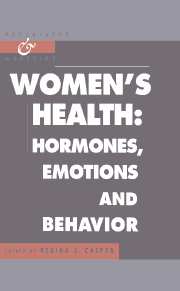Book contents
- Frontmatter
- Contents
- Preface
- 1 Growing up female
- 2 Reproduction and its psychopathology
- 3 Women's sexual function and dysfunction
- 4 Gender differences in brain morphology and in psychiatric disorders
- 5 Thyroid hormones in major depressive disorder and bipolar disorder
- 6 The hypothalamic-pituitary-adrenocortical system
- 7 The cost of starvation: Eating disorders
- 8 Coronary artery disease and women: Estrogens and psychosocial and lifestyle risk factors
- 9 The psychophysiology of breast cancer: Disease, hormones, immunity, and stress
- 10 The psychopharmacology of women
- 11 Intervention trials concerned with disease prevention in women
- References
- Index
2 - Reproduction and its psychopathology
Published online by Cambridge University Press: 08 February 2010
- Frontmatter
- Contents
- Preface
- 1 Growing up female
- 2 Reproduction and its psychopathology
- 3 Women's sexual function and dysfunction
- 4 Gender differences in brain morphology and in psychiatric disorders
- 5 Thyroid hormones in major depressive disorder and bipolar disorder
- 6 The hypothalamic-pituitary-adrenocortical system
- 7 The cost of starvation: Eating disorders
- 8 Coronary artery disease and women: Estrogens and psychosocial and lifestyle risk factors
- 9 The psychophysiology of breast cancer: Disease, hormones, immunity, and stress
- 10 The psychopharmacology of women
- 11 Intervention trials concerned with disease prevention in women
- References
- Index
Summary
Early writers, such as Hippocrates, saw the womb as the seat of emotions and invoked the image of the “wandering womb” as stirring up emotions in women (Veith, 1965). Women's cookery books and physicians' casebooks from the 17th century abound with prescriptions for “how to put the womb back in her place” with foul-smelling herbs such as asafoetida (Williams, 1990). The notion that the reproductive organs produced substances that could alter mentation was bolstered by reports in the late 19th century which asserted that the “juice” of guinea pig ovaries could cure the symptoms of hysteria (Corner, 1965).
A century later, there is no longer any doubt about the neuropharmacologic effects of the gonadal hormones. Moreover, fluctuations of gonadal steroids premenstrually, during pregnancy and postpartum and in the perimenopausal years, seem to increase the risk of emotional disturbances in certain women. It has become apparent that the ups and downs of hormonal secretion perturb neurotransmitter sites, which regulate emotions and cognition, and not the absolute hormone levels, which show little correspondence. This chapter first briefly reviews the psycho- and neurotropic effects of the gonadal hormones and examines their relationship to psychopathology. It then describes the clinical characteristics of reproductive cycle–related psychiatric syndromes, which can undermine a woman's self-confidence and raise doubts about her ability to function as a partner and a mother.
Keywords
- Type
- Chapter
- Information
- Women's HealthHormones, Emotions and Behavior, pp. 14 - 35Publisher: Cambridge University PressPrint publication year: 1997



